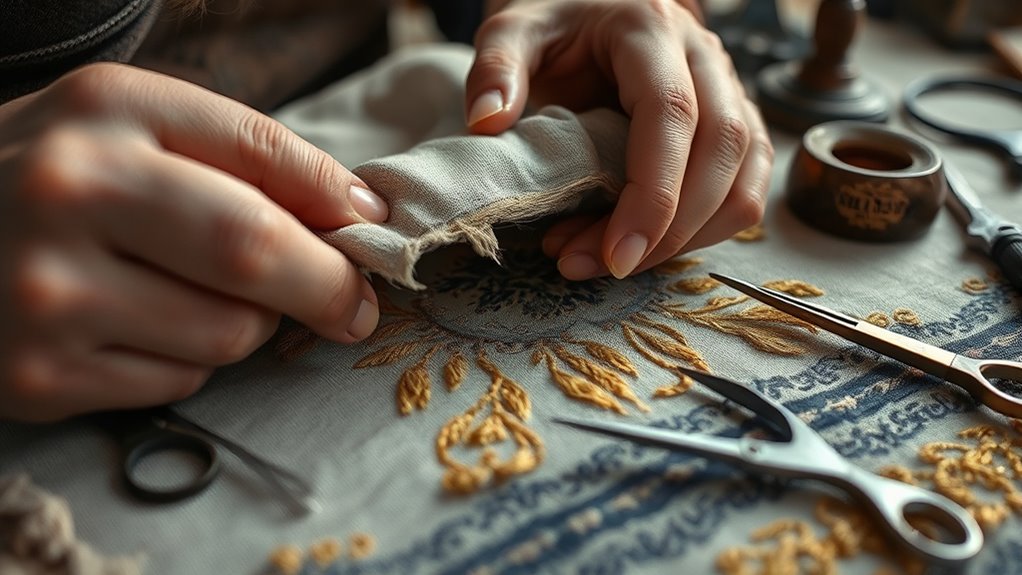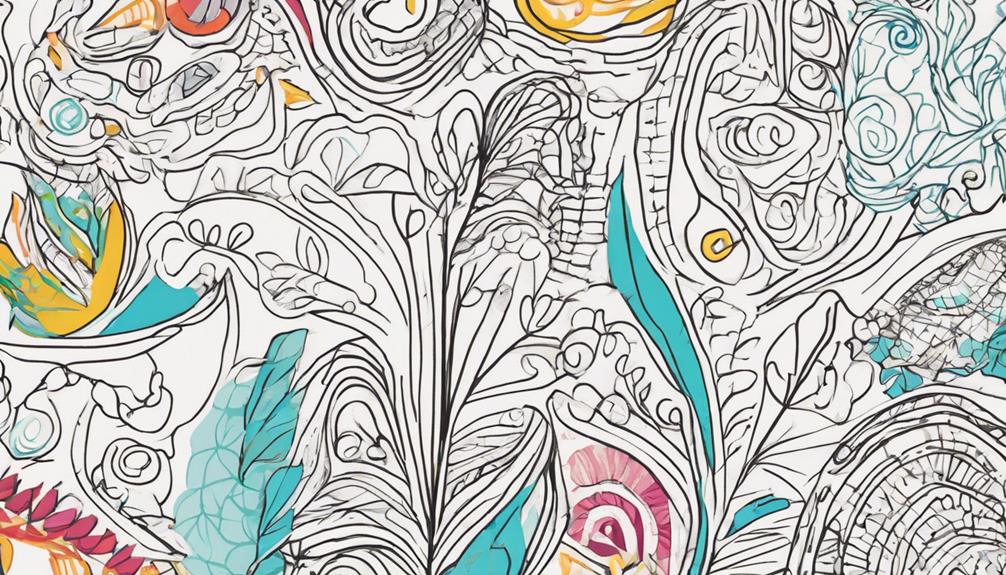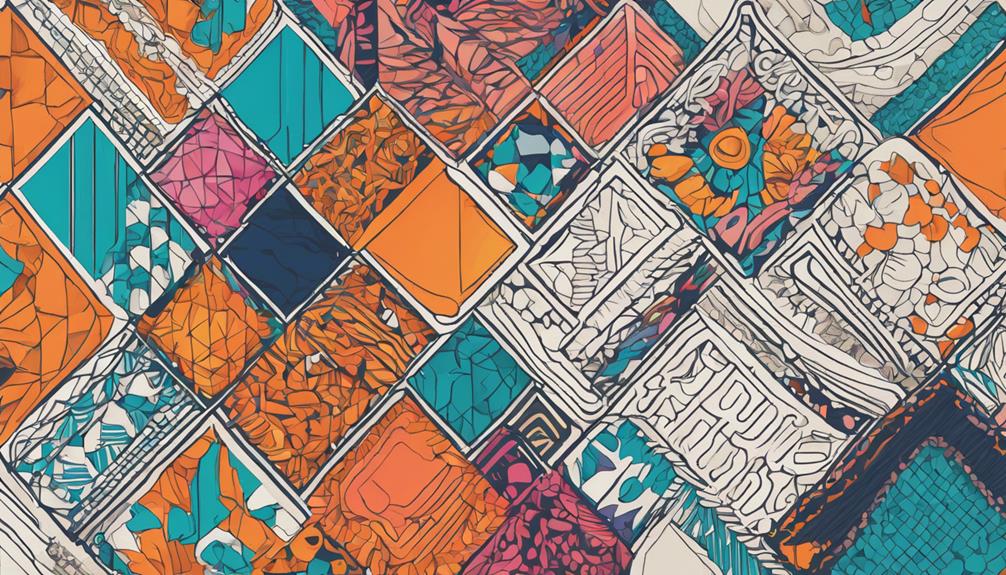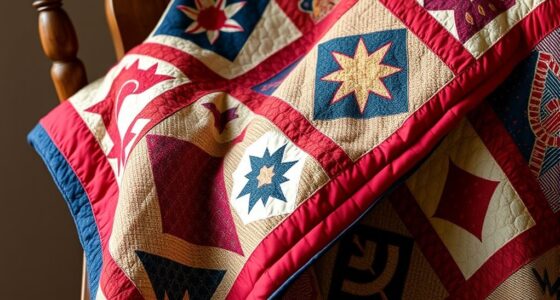When restoring antique textile art, start with gentle surface cleaning using soft brushes or vacuuming with a soft attachment to remove dust. Test a small hidden area first with distilled water if needed, avoiding excess moisture. Use conservation-grade materials for repairs, matching stitches to the original as closely as possible. Respect natural dye colors and avoid harsh chemicals to preserve authenticity. For detailed techniques and tips, discover how proper cleaning and careful repair methods can help your textile’s longevity.
Key Takeaways
- Always test cleaning methods on a hidden area to prevent dye or fiber damage.
- Use gentle, conservation-grade cleaning agents and avoid harsh chemicals.
- Employ soft brushing and controlled damp cleaning with distilled water for surface dust and dirt.
- Repair tears with hand-sewn stitches matching the original fabric to maintain authenticity.
- Document all restoration processes for future reference and ensure respect for original dyeing techniques.
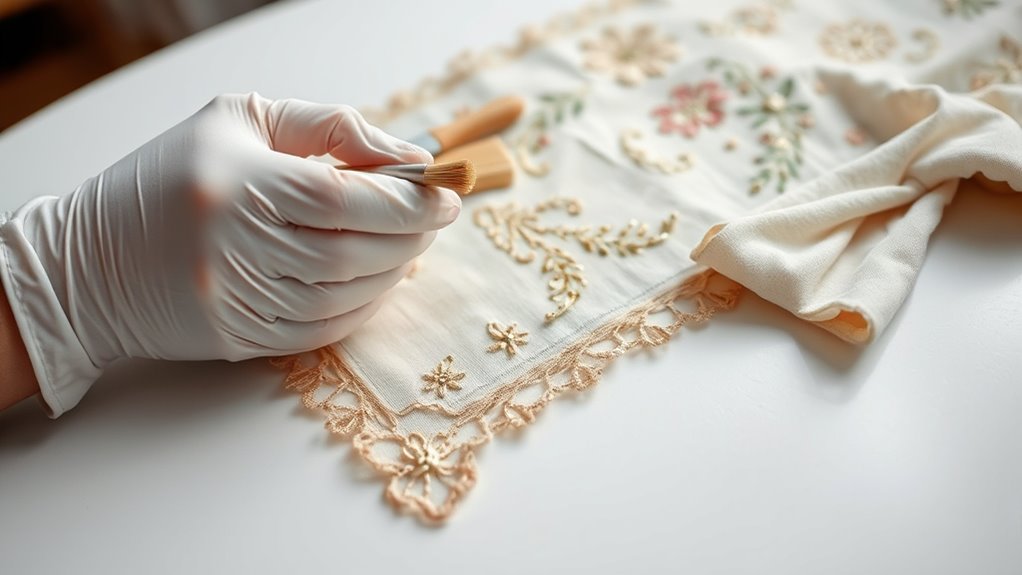
Restoring antique textile art requires careful attention to detail and a deep understanding of historical techniques. When you’re working on these delicate pieces, you need to be mindful of how they were originally created, especially in areas like fabric dyeing. Many antique textiles feature colors achieved through traditional fabric dyeing methods, which often involve natural dyes that can fade or change over time. To preserve their authenticity, you must use preservation techniques that respect the original materials and methods. This means avoiding harsh chemicals and opting for gentle, specially formulated cleaning agents that won’t damage the fibers or cause color bleeding. Understanding the intricacies of fabric dyeing helps you select appropriate cleaning and repair strategies, ensuring the piece retains its historical integrity.
Preserve antique textiles by respecting original dyeing techniques and using gentle, natural cleaning methods.
Before you begin cleaning, always test a small, inconspicuous area to see how the fabric responds. This simple step can prevent accidental damage to the dye or fibers. When dealing with stained or soiled textiles, you might employ gentle vacuuming with a soft brush attachment to remove surface dust and dirt without disturbing the fabric. For more stubborn dirt, a carefully controlled damp cleaning with distilled water may be necessary, but always avoid excessive moisture that could weaken the fibers or cause mold growth. Using conservation-grade materials ensures you don’t introduce harmful substances that could accelerate deterioration. Remember, the goal isn’t just cleaning but preserving the textile’s original appearance and structure. conservation-grade materials are essential for maintaining the integrity of delicate textiles over time.
Repairing antique textiles often involves mending tears or reinforcing fragile areas, but you have to do so with utmost precision. When sewing tears, choose threads and stitches that match the original fabric as closely as possible, ideally using historically accurate techniques. Sometimes, this means employing traditional hand-sewing methods rather than modern machine stitches. If the textile’s colors have faded, consider subtle touch-ups that don’t alter the overall appearance or compromise authenticity. Understanding fabric dyeing techniques used in the original creation can guide you in selecting dyes or pigments for any necessary retouching, ensuring color matches and longevity. Your goal is to stabilize and reinforce the piece without compromising its aesthetic or historical value.
Throughout the restoration process, always document your work thoroughly. This record helps you track what has been done and provides valuable information for future conservation efforts. By respecting historical fabric dyeing techniques and applying appropriate preservation methods, you ensure that these treasured textiles are preserved for generations to come. Restoring antique textile art is a delicate balance of skill, patience, and respect for the craftsmanship of the past. When you approach each piece with these principles, you help preserve its story and beauty for the future.
Frequently Asked Questions
How Can I Identify the Original Materials Used in My Antique Textile?
To identify the original materials in your antique textile, start with fiber identification, which can be done through microscopic analysis or burn tests. Next, perform dye analysis to determine the types of dyes used, such as natural or synthetic. These methods help you understand the textile’s age and origin, guiding proper cleaning and repair. Make sure to consult a textile conservator for accurate results and preservation advice.
What Are the Signs of Irreversible Damage in Antique Textiles?
Did you know that over 60% of antique textiles suffer from irreversible damage? You’ll notice signs like severe fiber degradation, where fibers become brittle or frayed, and color fading that’s impossible to restore. These indicators show the textile has reached a point beyond repair, making preservation efforts futile. Recognizing these signs early helps you decide whether to conserve or let the piece rest, ensuring you respect its historical integrity.
Is It Necessary to Consult a Professional Restorer for Minor Repairs?
You should consider consulting a professional restorer even for minor repairs, as DIY cleaning tips can sometimes lead to common repair mistakes. While small fixes might seem simple, improper handling can cause irreversible damage or worsen existing issues. A professional guarantees your antique textile art receives the proper care it needs without risking further harm. Their expertise helps preserve the piece’s historical integrity and prolong its lifespan.
How Should I Store Antique Textiles to Prevent Future Deterioration?
The best way to prevent future deterioration is by practicing proper storage, which involves controlling the environment around your textiles. You should store antique textiles in a cool, dry, and dark place, away from direct sunlight, humidity, and pests. Use acid-free boxes or tissue to wrap them, ensuring they’re well-supported. Consistently monitor temperature and humidity levels to maintain ideal environmental control, helping your textiles stay preserved for generations.
Can Natural Remedies Replace Commercial Cleaning Products for Textiles?
Natural remedies can sometimes substitute commercial cleaning products for textiles, especially if you prefer DIY cleaning and eco-friendly solutions. You might use gentle options like vinegar, baking soda, or mild soap to clean your antique textiles without harsh chemicals. However, always test a small area first to avoid damage. While natural remedies are eco-friendly, verify they’re effective and safe for your delicate textiles by researching proper techniques.
Conclusion
Restoring antique textile art requires patience and careful attention. By understanding the materials and techniques involved, you can effectively clean and repair these precious pieces. Think of it like revealing a story woven into every thread—each careful step reveals more of its history. Remember, gentle handling preserves the fabric’s integrity. With a little research and care, you bring these artworks back to life, allowing their beauty and history to shine for future generations.

